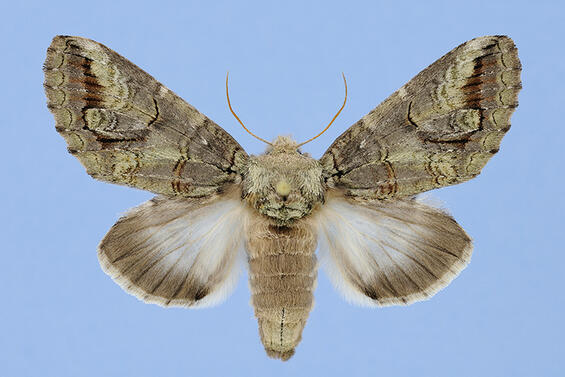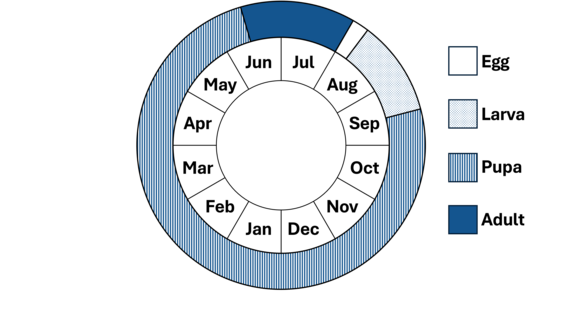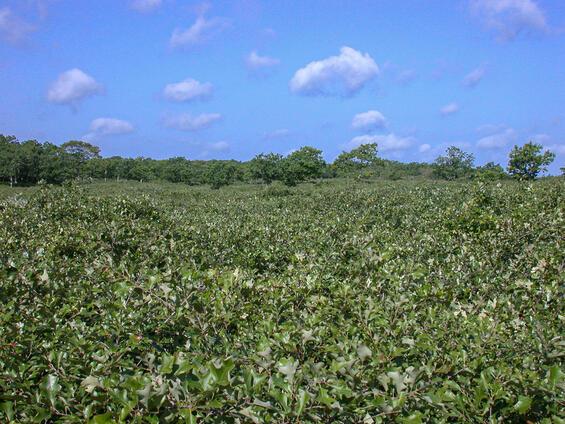- Scientific name: Heterocampa varia
- Species of Greatest Conservation Need (MA State Wildlife Action Plan)
- Threatened (MA Endangered Species Act)
Description
The sandplain heterocampa (Heterocampa varia) is a sexually dimorphic notodontid moth. Males are smaller, with a wingspan of 37-42 mm (~1.5 in), and have a white hind wing with a gray costal margin. Females are larger, with a wingspan of 42-46 mm (1.6-1.8 in), and have a hind wing that is light gray proximally and dark gray distally and along the costal margin. In both sexes, the anal angle of the hind wing has a black dot. The forewings of both sexes are similar: the ground color is gray to olive green, with a lighter apical patch ranging from pale green to cream-colored. Many individuals have reddish-brown shading distal to the pale apical patch, in the area of the reniform spot, and/or proximal to the antemedial line. There is a black, scalloped terminal line, and black dashes may be present in the subterminal area. Both postmedial and antemedial lines are black in color and consist of double, parallel lines; the postmedial line is jagged and the antemedial line is wavy. The basal line is black, single, and relatively straight. There is a black apical dash, and the reniform spot is reduced to an angled black dash. Both sexes have an olive green head and thorax, and a grayish-tan abdomen. The male of a common congener, the oblique heterocampa (Heterocampa obliqua), is so similar in wing pattern to the sandplain heterocampa that examination of the genitalia may be necessary for definitive identification. The female of the oblique heterocampa may be distinguished from the sandplain heterocampa by the presence of a large brown to reddish-brown patch, often outlined with black, on the forewing between the reniform spot and the wing apex.


Sandplain heterocampa, Heterocampa varia. Left, male. Right, female.
Life cycle and behavior

In Massachusetts, adult sandplain heterocampa moths fly from late June through early August. Eggs are laid on the larval host plant, which is primarily scrub oak (Quercus ilicifolia) in Massachusetts, although dwarf chinquapin oak (Quercus prinoides), post oak (Quercus stellata), or other oaks may occasionally be used. Eggs hatch about a week after oviposition. Fully-grown larvae reach a length of 40-45 mm (1.6-1.8 in), after feeding for as few as four or as long as seven weeks, and then burrow into the soil for pupation. The pupa overwinters, and some moths emerge the following year; however, most individuals overwinter twice, emerging two years after the previous generation.
Distribution and abundance
The range of the sandplain heterocampa is limited to the Atlantic Coastal Plain, from Massachusetts in the north, to the south on eastern Long Island, New York and in the New Jersey pine barrens; and disjunctly on the coastal plain of the Carolinas, Georgia, and Florida (Schweitzer et al. 2011). In Massachusetts, the sandplain heterocampa only occurs on the offshore islands of Martha’s Vineyard and Nantucket.

Distribution in Massachusetts.
2000-2025
Based on records in the Natural Heritage Database.
Habitat
In Massachusetts, the sandplain heterocampa inhabits coastal pitch pine-scrub oak barrens, as well open, savanna-like oak woodland and occasionally sandplain heathlands and grasslands with a scrub oak component.
Healthy habitats are vital for supporting native wildlife and plants. Explore habitats and learn about conservation and restoration in Massachusetts.

Coastal pitch pine-scrub oak barrens with scattered oak trees, ideal habitat for the sandplain heterocampa. Habitat managed by DCR and TNC at Manuel F. Correllus State Forest.
Threats
The sandplain heterocampa is threatened by habitat loss and fire suppression in its disturbance-dependent habitats, in particular sandplain pitch pine-scrub oak barrens. Other potential threats include introduced generalist parasitoids, aerial insecticide spraying, non-target herbicide application, and off-road vehicles. The effect of a warming climate may not be detrimental to this species in Massachusetts; its range extends south to Florida, suggesting adaptation to warm temperatures.
Conservation
Land protection and habitat management are the primary conservation needs of this species in Massachusetts. In particular, coastal pitch pine-scrub oak barrens and open oak woodland should be conserved, restored, and managed to maintain habitat for this species and the entire suite of rare and threatened species dependent on such habitats.
Survey and monitoring
The distribution of the sandplain heterocampa in coastal pitch pine-scrub oak barrens and open oak woodland is well documented. Known populations of this species should be surveyed to document persistence at least once every 25 years; every 10 years is more desirable when practicable.
Management
Management of coastal pitch pine-scrub oak barrens and oak woodland benefits a suite of rare and threatened species, and habitat condition should be monitored and management adapted as needed. For the sandplain heterocampa, open barrens with a shrub layer including scrub oak (Quercus ilicifolia) is of particular importance; open-canopy oak woodland co-occurring on the landscape with barrens is equally important habitat for this species.
Research needs
The natural history and conservation needs of the sandplain heterocampa are relatively well known. However, as with other species with a geographic range mostly south of Massachusetts, the future effects of a warming climate on this species are unpredictable and should be documented.
References
Schweitzer, D.F., M.C. Minno, and D.L. Wagner. 2011. Rare, Declining, and Poorly Known Butterflies and Moths (Lepidoptera) of Forests and Woodlands in the Eastern United States. Forest Service, U.S. Dept. of Agriculture, Washington, DC. 517 pp.
Contact
| Date published: | March 7, 2025 |
|---|